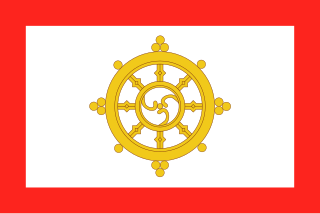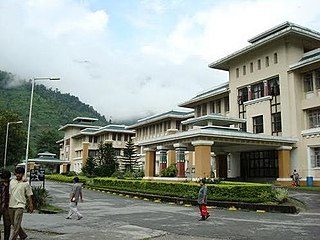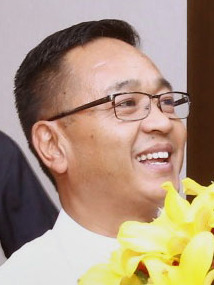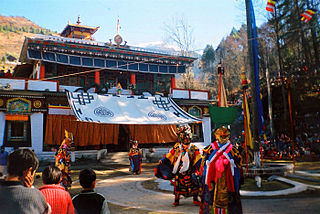Related Research Articles

Sikkim is a state in northeastern India. It borders the Tibet Autonomous Region of China in the north and northeast, Bhutan in the east, Province No. 1 of Nepal in the west, and West Bengal in the south. Sikkim is also close to the Siliguri Corridor, which borders Bangladesh. Sikkim is the least populous and second smallest among the Indian states. Situated in the Eastern Himalaya, Sikkim is notable for its biodiversity, including alpine and subtropical climates, as well as being a host to Kangchenjunga, the highest peak in India and third highest on Earth. Sikkim's capital and largest city is Gangtok. Almost 35% of the state is covered by the Khangchendzonga National Park – a UNESCO World Heritage Site.

Northeast India is the easternmost region of India representing both a geographic and political administrative division of the country. It comprises eight states – Arunachal Pradesh, Assam, Manipur, Meghalaya, Mizoram, Nagaland, Tripura and Sikkim.

Indian nationality law details the conditions by which a person holds Indian nationality. The two primary pieces of legislation governing these requirements are the Constitution of India and the Citizenship Act, 1955. All persons born in India between 26 January 1950 and 1 July 1987 automatically received citizenship by birth regardless of the nationalities of their parents. Between 1 July 1987 and 3 December 2004, citizenship by birth was granted if at least one parent was a citizen. Individuals born in the country since then receive Indian citizenship at birth only if both parents are Indian citizens, or if one parent is a citizen and the other is not considered an illegal migrant.

The Lepcha are among the indigenous peoples of the Indian state of Sikkim and Nepal, and number around 80,000. Many Lepcha are also found in western and southwestern Bhutan, Tibet, Darjeeling, the Province No. 1 of eastern Nepal, and in the hills of West Bengal. The Lepcha people are composed of four main distinct communities: the Renjóngmú of Sikkim; the Dámsángmú of Kalimpong, Kurseong, and Mirik; the ʔilámmú of Ilam District, Nepal; and the Promú of Samtse and Chukha in southwestern Bhutan.

Gangtok is a city, municipality, the capital and the largest populated place of the Indian state of Sikkim. It is also the headquarters of the Gangtok District. Gangtok is in the eastern Himalayan range, at an elevation of 1,650 m (5,410 ft). The city's population of 100,000 are from different ethnicities such as Gorkhas, Bhutia and Lepchas. Within the higher peaks of the Himalayas and with a year-round mild temperate climate, Gangtok is at the centre of Sikkim's tourism industry.

Nathu La (Tibetan: རྣ་ཐོས་ལ་, Wylie: Rna thos la, THL: Na tö la, Chinese: 乃堆拉山口) is a mountain pass in the Dongkya Range of the Himalayas between China's Yadong County in Tibet, and the Indian states of Sikkim and West Bengal in Bengal, South Asia. The pass, at 4,310 m (14,140 ft), connects the towns of Kalimpong and Gangtok to the villages and towns of the lower Chumbi Valley.

The history of Sikkim, begins with indigenous Lepchas contact with early Tibetan settlers. Historically, Sikkim was a sovereign Monarchical State in the eastern Himalayas. Later a protectorate of India followed by merger with India and official recognition as a state of India. Lepchas were the main inhabitants as well as the Ruler of the land upto 1641. Lepchas are generally considered to be the first people, indigenous to Sikkim also includes Darjeeling.

Vinayaka Krishna Gokak, abbreviated in Kannada as Vi. Kru. Gokak, was a major writer in the Kannada language and a scholar of English and Kannada literatures. He was the fifth writer to be honoured with the Jnanpith Award in 1990 for Kannada language, for his epic Bharatha Sindhu Rashmi. Bharatha Sindhu Rashmi deals with the Vedic age and is perhaps the longest epic narrative in any language in the 20th Century. In 1961, Gokak was awarded the Padma Shri from the Government of India for Dyava Prithvi.

The Chinmaya Mission is a Hindu religious and spiritual organization engaged in the dissemination of Vedanta, the science of the self as expounded in the Vedas, particularly the Upanishads, and other Hindu scriptures such as the Bhagavad Gita. The Chinmaya Mission was established in India in 1953 by devotees of the renowned Vedanta teacher Swami Chinmayananda Saraswati from present-day Kerala, India.

Vinayaka Mission's Research Foundation is a UGC, Government of India recognized private deemed-to-be-university located in Salem, Tamil Nadu, India. In 2015, the University was accredited by National Assessment and Accreditation Council.

The Kingdom of Sikkim, officially Dremoshong until the 1800s, was a hereditary monarchy in the Eastern Himalayas which existed from 1642 to 16 May 1975. It was ruled by Chogyals of the Namgyal dynasty.

The higher education system in India includes both private and public universities. Public universities are supported by the Government of India and the state governments, while private universities are mostly supported by various bodies and societies. Universities in India are recognized by the University Grants Commission (UGC), which draws its power from the University Grants Commission Act, 1956. In addition, 15 Professional Councils are established, controlling different aspects of accreditation and coordination. Private universities in India are regulated under the UGC Regulations, 2003. Per the UGC act and these regulations, private universities are established by an act of a local legislative assembly and listed by the UGC in the Gazette upon receiving the act. As confirmed by ruling of the Supreme Court of India, recognition by the UGC is required for the university to operate. Also, per the 2003 regulations, the UGC sends committees to inspect the private universities and publishes their inspection report.
The Convention of Calcutta or Anglo-Chinese Convention of 1890, officially the Convention Between Great Britain and China Relating to Sikkim and Tibet, was a treaty between Britain and Qing China relating to Tibet and the Kingdom of Sikkim. It was signed by Viceroy of India Lord Lansdowne and the Chinese Amban in Tibet, Sheng Tai, on 17 March 1890 in Calcutta, India. The Convention recognized a British protectorate over Sikkim and demarcated the Sikkim–Tibet border.

Prem Singh Tamang, better known as P. S. Golay, is an Indian politician and the current Chief Minister of Sikkim and leader and founder of the Sikkim Krantikari Morcha (SKM). Before forming the party, he was a key member of the Sikkim Democratic Front (SDF) Party.

Losoong is the Sikkimese New Year, of the Bhutia tribe, celebrated every year in December.

Doklam, Zhoglam, or Donglang, is an area with a plateau and a valley, lying between China's Chumbi Valley to the north, Bhutan's Ha Valley to the east and India's Sikkim state's Nathang Valley to the west. It has been depicted as part of Bhutan in the Bhutanese maps since 1961, but it is also claimed by China. The dispute has not been resolved despite several rounds of border negotiations between Bhutan and China. The area is of strategic importance to all three countries.
Jyoti Prakash Tamang is an Indian food microbiologist, working on fermented foods and beverages of Asia for last 36 years and the Senior Professor in Microbiology of the Sikkim Central University. Known for his studies on fermented food, Tamang is an elected fellow of the National Academy of Agricultural Sciences, Indian Academy of Microbiological Sciences and the Biotech Research Society of India. The Department of Biotechnology of the Government of India awarded him the National Bioscience Award for Career Development, one of the highest Indian science awards, for his contributions to biosciences in 2004, and International Centre for Integrated Mountain Development (ICIMOD)-Mountain Chair (2019-2022).
The first case of the COVID-19 pandemic in India was reported on 30 January 2020, originating from China. Slowly, the pandemic spread to various states and union territories including the state of Sikkim.
Sikkim Professional University, erstwhile Vinayaka Missions Sikkim University, Gangtok, Sikkim, India is a State Private University founded in the year 2008 under Sikkim Professional University Act, Sikkim of Sikkim State Assembly. SPU is recognized by the University Grants Commission of India (UGC), The Indian Nursing Council (INC), and the Pharmacy Council of India (PCI). Formerly, the University was well known by Vinayaka Missions Sikkim University but now the name has been amended to Sikkim Professional University as per The Vinayaka Missions Sikkim University (Amendment) Act, 2020;.
References
- ↑ "Private University Sikkim". University Grants Commission (India) . Retrieved 10 December 2017.
- ↑ "Vinayaka Missions Sikkim University". 4icu. Retrieved 10 December 2017.